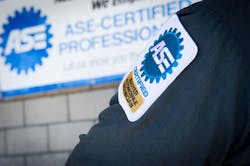The National Institute for Automotive Service Excellence (ASE) was founded in 1972 to determine the competency of technicians through testing. Individuals who have the proper field experience and pass the tests get a certification that lasts for five years.
ASE certifications have been part of my career since I started tech school. Throughout my career, I have been hired and paid based on my certifications. Not only that, but different entities from OEM manufacturers to certain municipalities, have accepted these certifications in place of required training or have required them to work on vehicles in different parts of the country.
Now, I find myself in need of recertification before the end of 2018. Wanting to maintain my ASE Master Technician status, I am again starting a process that I have used to pass the tests and remain ASE certified.
I think it’s something that could help all techs, so, here it is!
The process
The first thing to do is NOT wait until the last minute to get started! Get registered and select the testing center you wish to use. Last time I recertified, I learned that the hard way, having to drive over an hour to the testing facility. Worse was the fact that I needed to do it twice since I had to split the testing up over two days. Having a long drive after testing is not too pleasant, so do yourself a favor and don’t wait!
Test-taking stinks. You need to have a system in place that helps you answer questions. For many, knowledge isn’t the problem; it’s the way the questions are worded that trip them up. I found I had this issue long ago while preparing for the test. I took a study guide test, and when I graded myself, I failed! I was shocked. I went back and reviewed the questions I got wrong and quickly realized that I knew the answers, but how I interpreted the questions was my problem, not the material.
I sought out every source I could, finding ASE-like tests and questions. I looked online, in study guides, and old school books. Online, I found tests with extremely dated technical information, but they still were in the common question formats I had to learn to work with. I set aside some time every day to practice working with the questions.
Doing this gives has several advantages:
- You get used to reading the questions and answers. It takes practice.
- It prepares you for sitting and taking the tests. This helps to get the idea that the test is timed off of your mind. You build test-taking stamina.
- As you go over the questions and answers, you are reviewing the material.
- You get familiar with the different question formats you will be facing.
Understanding how to read and answer the different question formats is also key to success.
The Questions
Completion/Direct:
The first type of question we will deal with is the direct, or completion, kind of questions. These describe the vehicle equipment and a symptom that can occur, then either ask a question or ask you to complete the statement with “the most likely cause” answer.
Here is an example:
A customer states that the Traction Control and ABS Lights come on and stay on when driving a short distance after starting the vehicle. Which of these is the most likely cause?
- Damaged tone ring on a front axle
- Brake pads cracked
- Coolant leak
- Starter pinion
Read the question and note everything it tells you about the situation. Next, consider all the answers. Eliminate the answers that are obviously incorrect, then choose the correct answer.
True or False:
Another type of question is the Technician A or B questions. These are basically “True or False” questions. Read each technician’s take on the issue listed. Decide if they are either true or false, then choose the correct answer based on the tech’s opinions.
The starter in a vehicle cranks slower than expected. The battery tests good so the circuit is suspect. Who is suggesting the better way to check the circuit?
Technician A says that a resistance reading should be taken of the circuit.
Technician B says that a voltage drop test should be performed on the circuit.
Who is right?
- A only
- B only
- Both A and B
- Neither A nor B
Technician A’s statement is False. Technician B’s statement is true which means that (B) only is correct. To help keep track of each tech’s answer, you can use the provided scrap paper and have a “A – B” column as you look at each tech putting a T or F next to the tech letter. This way, you don’t have to remember it, and you can focus on answering the question.
Except and Least Likely:
“Except and Least Likely” types of questions are our next format to look at. Before each one, you will see the explanation reminding you how to look at these questions based on whether it is an Except question or Least Likely question. On the example below, I would think, “No refrigerant is a likely cause. The thermostat stuck open is the least likely cause.”
This question uses the words LEAST LIKELY. Look for the choice that could NOT or would be LEAST LIKELY to cause the described situation. Read the entire question carefully before choosing your answer.
Air conditioning is turned on but the air coming from the vents is not getting cooled. Which of these is the LEAST LIKELY cause?
- No refrigerant
- Clutch Relay Failure
- Thermostat Stuck Wide Open
- Blown Fuse
“Thermostat Stuck Wide Open is the LEAST LIKELY cause of this symptom,” I say in my head, then select the answer. I will go back and be sure that I answered the actual question being asked.
The Lesson
Taking the time to go over these questions from practice tests helps build your test-taking stamina. You get into a rhythm and build a system to approach each question. This helps take what I call the “Test Stress” out of the equation. You get to focus on the actual information you are being tested on, not the form of testing.
Consider only the provided answers to each question. Do not compare it to something you may have seen in the field, especially if no answers match your experience. Choose the best answer.
Eliminate the answers that you know are incorrect and focus only on the ones you feel apply. Reread the question and look at the remaining answers. Do not spend too much time on any one question. Do choose the best answer you have at this time, mark the question number on the screen to return to it when you have completed the test.
As you go through the test, another question might give you a different point of view and possible answers to difficult questions you struggled with. When you’ve reached the end of the test, you can go back to the questions you marked and reconsider your original answers. But be careful. Many times, your intuition on choosing an answer on the first pass is correct. My experience is that many test takers that go back and second guess themselves and turn correct answers into wrong ones.
Answer every question! You have a one in four chances to get the right answer. Not answering gives you zero chances. Even if you don’t know the correct answer, you may be able to eliminate some of the other answers, further increasing your chance of guessing right. Therefore, I say to always answer the questions you want to come back to in case you don’t have the time, or just plain forget to.
Studying & preparation
Online tests are limited, but I still recommend finding and doing as many as you can. Purchasing study guides is also well worth the investment. Purchasing the current guides is best. Trying to save money and buying older versions may not completely prepare you for the test. Also, keeping the new study guides in great shape will let you sell them after you pass the test helping to defray their costs.
To study, take a practice test and grade yourself; then read the given explanations for both the right and wrong answers. This not only further prepares you for the test questions, but makes you study the material at the same time. Don’t forget to look over the Task List given for each test. Identify the tasks that you may not be so familiar with and focus more time on studying and learning them.
The L1 Advanced Engine Performance Specialist Test comes with a booklet that represents a Composite Vehicle (available in print or online.) The Composite Vehicle exists so that all persons taking the L1 test are on a level playing field since OEM specific systems and sensors are eliminated. You do need to be familiar with the information provided about the Composite Vehicle and, just as importantly, where specific information is in the book. Knowing the booklet will save you time during the test. Spending less time searching for the location of the information in the booklet saves time for answering the questions.
This is my system for preparing for my ASE recertification tests. It works for me. Take what you want from it and add your own methods and ideas that work for you. Then practice and study even though you may work in the field every day. Go back to the basics because they will help too. Read the questions completely and carefully. Relax.




